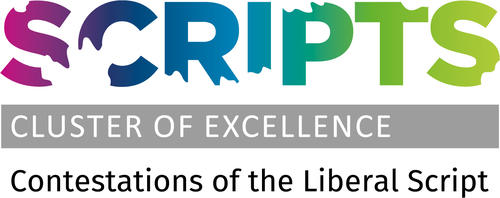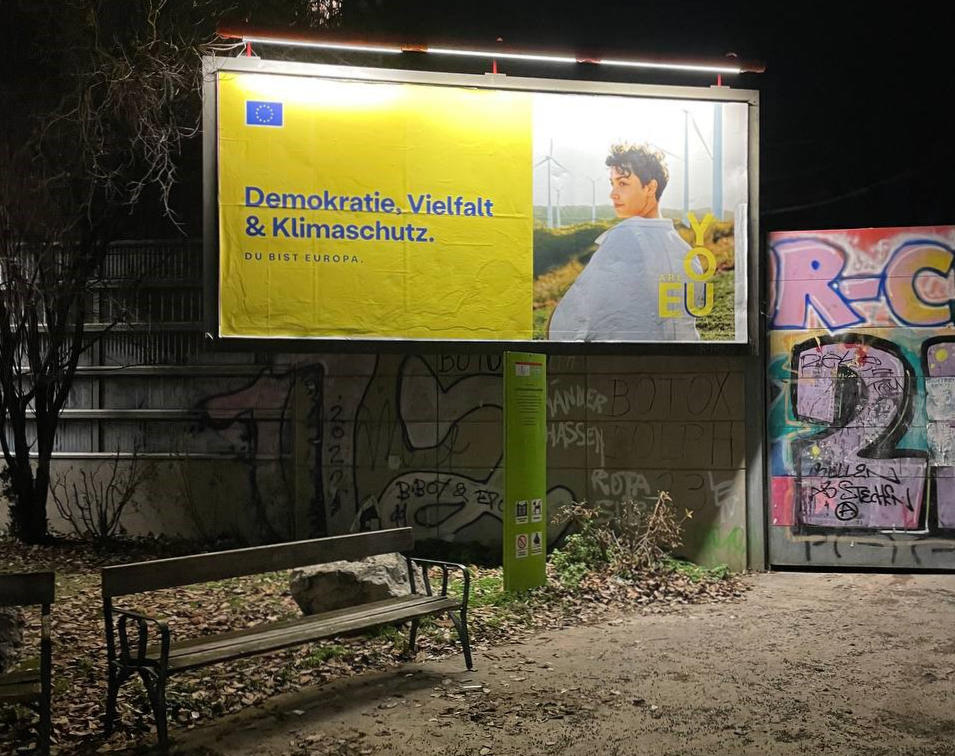A matter of perception: Understanding the EU’s image problem
SCRIPTS Blog Post No. 75 by Marlene Ritter
№ 75/2024 from Jul 26, 2024
Shortly after the EU election in June, Jessica Gienow-Hecht, Tobias Klee, Marlene Ritter, and Lesar Yurtsever organised an international SCRIPTS workshop titled “Welcome to the (Il)liberal State: Place Branding as a Historical Practice”. Doctoral Researcher Marlene Ritter relates the findings of the workshop to the recurring debate on the EU’s struggle to make a convincing case for itself. What is there to learn from a historical perspective — in assessing, but also addressing this problem? Spoiler alert: One cannot not communicate. And this is part of the problem, but it may be part of a long-term solution as well.1
The polls predicting grand wins for openly anti-European parties in the EU elections on 9 June rekindled a well-rehearsed debate. Ever since the so-called Eurozone crisis, politicians, journalists, think tankers, and academics have repeatedly uttered their concerns about the EU’s apparent image problem.2 At the same time, no one really seems to know what to do about it. “Convinced Europeans” like former Luxembourgish Foreign Minister Jean Asselborn keep calling for ‘a new great narrative for Europe’.3 Yet, what this narrative could be, or what this would mean in practical terms, remains unclear.
Considering the results of the EU election and their possibly wide-ranging consequences, it may be a poor consolation that the image problem of European politics is nothing new. In fact, the historical trajectory of bureaucrats’ attempts to sell Europe goes back at least to the post-war years. And just like then, the invocation of European unity by politicians is a reliable indicator of an actual (or perceived) lack thereof.4 What else is there to learn from a historical perspective — in assessing, but also addressing this challenge?
Liberal self-branding: a specific challenge?
Three days after the election, Jessica Gienow-Hecht, Tobias Klee, Lesar Yurtsever, and myself organised a SCRIPTS workshop in Berlin, titled “Welcome to the (Il)liberal State: Place Branding as a Historical Practice”. The EU election results were in the back of our heads, but our focus was historical. Drawing on a diverse selection of historical case studies, we discussed and compared the strategies of self-proclaimed liberals with those of illiberal or authoritarian governments and postcolonial states.
What we found is that liberal self-branding poses a specific challenge, i. e. to avoid the notion of manipulative propaganda. Jessica Gienow-Hecht emphasised that liberals appear particularly prone to relying on the self-evidence of their political arguments. Yet, other than that, the cases presented displayed similar profiles and intentions, irrespective of ideology. Many of the historical actors examined hoped that branding — in its various forms — would remedy an urgent problem. They all struggled to translate their ambitions to concrete campaigns, images, and political messages. And all of them remained remarkably vague regarding the superior characteristics of the nation, the regime, or the political project in question.
With these findings in mind, there are a number of observations to make about the recurring debate on the proclaimed need for ‘a new narrative for Europe’. Above all, it implicitly problematises the way in which the EU’s lack of appeal contests its legitimacy in the public eye. But why is it that the EU has such a hard time selling itself to begin with?
The EU’s image problems: incoherence and habituation
One of the many challenges of EU politics is that they always project an image, whether this is intended or not. And this image is neither necessarily favourable, nor coherent. EU politics are notorious for confusing bureaucratic structures and a lack of transparency: We have all heard half-hearted jokes about the EU regulating the curvature of cucumbers. But many of us would have a hard time explaining how the different EU institutions actually work and how they relate to each other, let alone our everyday lives.
Furthermore, the idea of a liberal, cosmopolitan Europe is constantly called into question by its inner contradictions and moral double-standards: Each year, the European Parliament awards the so-called Sakharov Prize, commonly referred to as the EU human rights prize. At the same time, the EU knowingly accepts the wretched deaths of thousands of people at its external frontiers, especially in the Mediterranean. In other words: There is arguably a mismatch between what people mean when they speak of “the European idea” or “European values” as opposed to their institutional and political implementation in the form of the EU.5
Secondly — and this is part of the problem description as well — the EU’s appeal suffers from a fundamental disposition of the human psyche: We are quick to get used to what is pleasant. Yet, we are categorically bad at appreciating the absence of worries, fear, and discomfort. And that is exactly what European integration stands for.
Two of its central promises are, first, the absence of war among its member states, and second, the absence of borders within Europe. On both, the EU, its predecessors, and other European organisations have constantly delivered for over 70 years. And still, these same organisations have always had a hard time maintaining awareness for these achievements. As recently observable in response to the Russian invasion in Ukraine, this also means that external threats to this “normality” can have a stabilising effect — but only as long as they are perceived as such.6
Branding is key, but where does it end?
Evidently, there are no easy solutions to the EU’s apparent inability to convincingly brand itself. Its long historical trajectory only illustrates that point. The recent doubling of the European Commission’s annual communication budget (starting in 2024) does acknowledge the situation. But even the most well-funded communications strategy will not swiftly correct a reputation that has been established over decades. Plus, it will not change anything unless it recognises that the EU’s image problem is not just a matter of “the brand”, but of the “product”, too.7 Legitimacy is a matter of perception. And whether it comes to the perceived quality of political participation and representation (what political scientists call ‘input legitimacy’), the perceived quality of governance processes (‘throughput legitimacy’), or the perceived effectiveness of politics (‘output legitimacy’), the EU has much-debated deficits.8
This realisation underlines the intricacy of coming up with ‘a new narrative for Europe’. And it raises conceptual questions, too: Where does branding begin? Where does it end? The definition we used for the workshop views it as ‘a deliberate, collective effort . . . to generate a viable representation of a geographical-political-economic-social entity.’9 Establishing a viable representation of the EU may therefore begin with a doubled communications budget. But it cannot end there. For it will not change the fact that the EU is, in fact, an opaque administration far away from the everyday lives of its constituents.
This is not an argument against a well-grounded communication strategy, quite the opposite. A political project as abstract as European integration does not simply explain itself — especially when its achievements are so difficult to impart. It does require deliberate communication efforts to complement what is happening on the political stage. Still, these efforts can only be effective if EU officials and representatives internalise that communication is more than the responsibility of the PR department.
It is complex, but ultimately, it is also quite simple: One cannot not communicate.10 And in the case of the EU, this is part of the problem — but it is part of the solution, too. From a historical perspective, it is clear that there is no quick fix to a damaged reputation. Changing the EU’s image for the better will take a lot of political will, creativity, and above all: time.
1 I would like to thank Christiane Cromm, Jessica Gienow-Hecht, Tobias Klee, Sebastian Lesser, and Lesar Yurtsever for their attentive reading of an earlier version of this piece.
2 According to the most recent Eurobarometer, less than 50% (44%) of EU citizens have a positive image of the EU. 49% states that they tended not to trust the EU. Cf. ‘Standard Eurobarometer 101: Public Opinion in the European Union’, Spring 2024; for calls for ‘a new narrative for Europe’, cf. for example Gerd Appenzeller, ‘Europa braucht eine neue Erzählung’, Tagesspiegel, 10 January 2011; Goethe Institute, ‘Event Series “Neue Wir-Erzählungen: Eine Zukunftsressource Für Europa”’, Veranstaltungen, 13 May 2018; Povl Christian Henningsen, ‘We Need a New Narrative for Europe’, New Europeans, 30 July 2019; Daniel Innerarity et al., eds., A New Narrative for a New Europe (London: Rowman and Littlefield, 2018).
3 Jan Diesteldorf and Hubert Wetzel, ‘“Europa braucht wieder eine große Erzählung” (Interview with Jean Asselborn)’, SZ Online, 28 December 2023 (translation my own).
4 Bo Stråth, Europe’s Utopias of Peace: 1815, 1919, 1951. Europe’s Legacy in the Modern World (New York: Bloomsbury Academic, 2016).
5 As Hans Kundnani puts it: ‘the EU has come to see a hard external border as the necessary corollary of the removal of internal borders’, especially since the so-called refugee crisis in 2015. Cf. Hans Kundnani, Eurowhiteness: Culture, Empire and Race in the European Project (Oxford: Oxford University Press, 2023), 17.
6 In 1963, Geoffrey Barraclough summarised this dynamic as follows: European unity, he wrote, ‘remains strong only as long as the threat, or alleged threat, to Europe remains strong; it is a temporary unit based on a momentary community, or supposed community, of interests and it quickly disintegrates as soon as the immediate purpose becomes less urgent.’ Cf. Geoffrey Barraclough, European Unity in Thought & Action (Oxford: Basil Blackwell, 1963), 53–54.
7 Hans von der Burchard, ‘The EU Is Getting a German-Infused PR Machine — with Double the Money’, Politico, 16 June 2023.
8 Vivien A. Schmidt, Europe’s Crisis of Legitimacy: Governing by Rules and Ruling by Numbers in the Eurozone (Oxford: Oxford University Press, 2020).
9 Carolin Viktorin et al., ‘Beyond Marketing and Diplomacy: Exploring the Historical Origins of Nation Branding’, in Nation Branding in Modern History, ed. Carolin Viktorin et al. (New York: Berghahn Books, 2018), 1.
10 This phrase was famously coined by Paul Watzlawick. Cf. Paul Watzlawick, Janet H. Beavin, and Don D. Jackson, Menschliche Kommunikation. Formen, Störungen, Paradoxien, 13th ed. (Bern: Hogrefe, 2017).
Marlene Ritter is a PhD candidate at SCRIPTS. She is currently writing a dissertation on Western European image politics in the post-war years. Based on both textual and visual archival material, she analyses how early Western European organisations like the European Coal and Steel Community and the Council of Europe tried to establish and legitimise themselves, and why they had such a hard time doing so.

